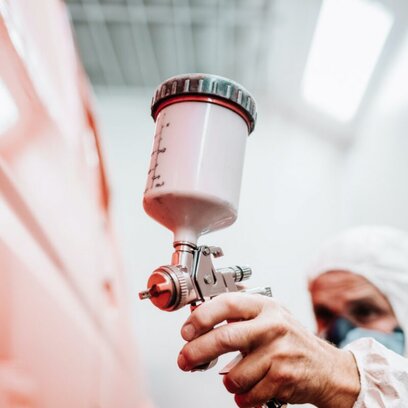Key Benefits of GCC in Paints & Coatings
-
High Opacity & Diding power: GCC improves coverage by enhancing light scattering, reducing pigment demand.
-
Brightness & color consistency: Natural whiteness improves overall paint brightness and ensures uniformity.
-
Smaller particle sizes maximize light scattering, improving opacity and hiding power, reducing the need for TiO₂.
-
Pigment extender: Reduces dependence on expensive Titanium Dioxide (TiO₂) while maintaining performance.
-
Lower raw material costs: Enhances value without compromising quality.
-
These grades offer a balance between performance and cost savings, enabling higher GCC loadings without compromising opacity.
-
Optimized Viscosity control: Ensures smooth application and better flow behavior in formulations.
-
Enhanced application properties: Improves leveling, spreadability, and resistance to sagging.
-
Medium-sized particles improve flow properties, reduce viscosity, and enhance paint spreadability.
-
Acid-coated grades help with better dispersion in solvent-based formulations.
-
Abrasion & Scrub resistance: Increases the lifespan of coatings, particularly in high-wear environments.
-
UV & moisture Stability: Ensures color retention and protection against environmental damage.
-
Finer particles enhance coating cohesion, improving abrasion resistance, scrub resistance, and UV stability.
-
Acid-coated grades improve resistance in harsh environments.
-
Customizable finish: Different GCC grades allow for controlled gloss or matte effects in coatings.
-
Consistent surface appearance: Enhances final coating aesthetics.
-
Finer particles (1–2 μm) contribute to high gloss.
-
Coarser grades (5–10 μm) help in achieving matte or semi-matte effects.
-
Buffering Capacity: Helps maintain stable pH levels in formulations, enhancing paint durability.
-
Chemical Resistance: Ensures compatibility with a broad range of binders and additives.
-
Cemix GCC provides stable pH buffering, preventing degradation in water-based and solvent-based paints. Acid-coated versions improve binder compatibility.
-
Eco-Friendly Composition: Supports the development of low-VOC, sustainable coatings.
-
Lower Carbon Footprint: Natural GCC has a smaller environmental impact compared to synthetic alternatives.
-
GCC is a natural, eco-friendly mineral that lowers VOC emissions. Acid-coated GCCs allow better dispersion in solvent-based coatings, reducing the need for synthetic dispersants.
Particle size distribution: The particle size distribution of calcium carbonate is a critical factor influencing its performance in paints and coatings. Fine particles (typically less than 1 micron) are preferred for applications requiring high opacity and smooth surface finish. Coarser particles (up to 10 microns) are used in applications where cost reduction and improved mechanical properties are prioritized. The optimal particle size distribution ensures uniform dispersion within the paint matrix, enhancing the overall properties of the coating.
Surface treatment types: Surface treatment of calcium carbonate is essential to improve its compatibility with paint resins. Common treatments include stearic acid coating, which enhances the hydrophobicity of calcium carbonate, improving its dispersion in non-polar systems. Silane coupling agents are also used to enhance the bonding between calcium carbonate and the paint matrix, resulting in improved mechanical properties and durability. Proper surface treatment ensures better adhesion, reduced moisture absorption, and enhanced processing stability.
Applications of GCC in Paints & Coatings
-
Enhanced opacity & whiteness: Ensures superior coverage with fewer layers.
-
Durability & color retention: Protects surfaces from fading and degradation.
-
In decorative paints, calcium carbonate improves opacity, brightness, and color stability. It acts as an extender, reducing the amount of titanium dioxide required, which lowers costs without compromising quality. Additionally, it enhances the rheological properties, ensuring smooth application and a uniform finish.
-
In industrial coatings, calcium carbonate increases abrasion resistance, mechanical stability, and weather resistance. It is used in primers and topcoats to improve durability and protect surfaces from environmental damage. The addition of calcium carbonate also helps in achieving the desired gloss levels and enhances the overall aesthetic appeal.
-
Improved Flow & Dispersion: Enhances application uniformity.
-
Cost Efficiency: Reduces reliance on expensive additives.
At Cemix, we offer high-purity GCC grades tailored to optimize performance in paints and coatings. Our precisely engineered products provide consistent particle size distribution, chemical stability, and excellent opacity enhancement. By incorporating Cemix GCC into your formulations, you achieve better durability, optimized rheology, and reduced costs, ensuring coatings that meet the highest industry standards.

